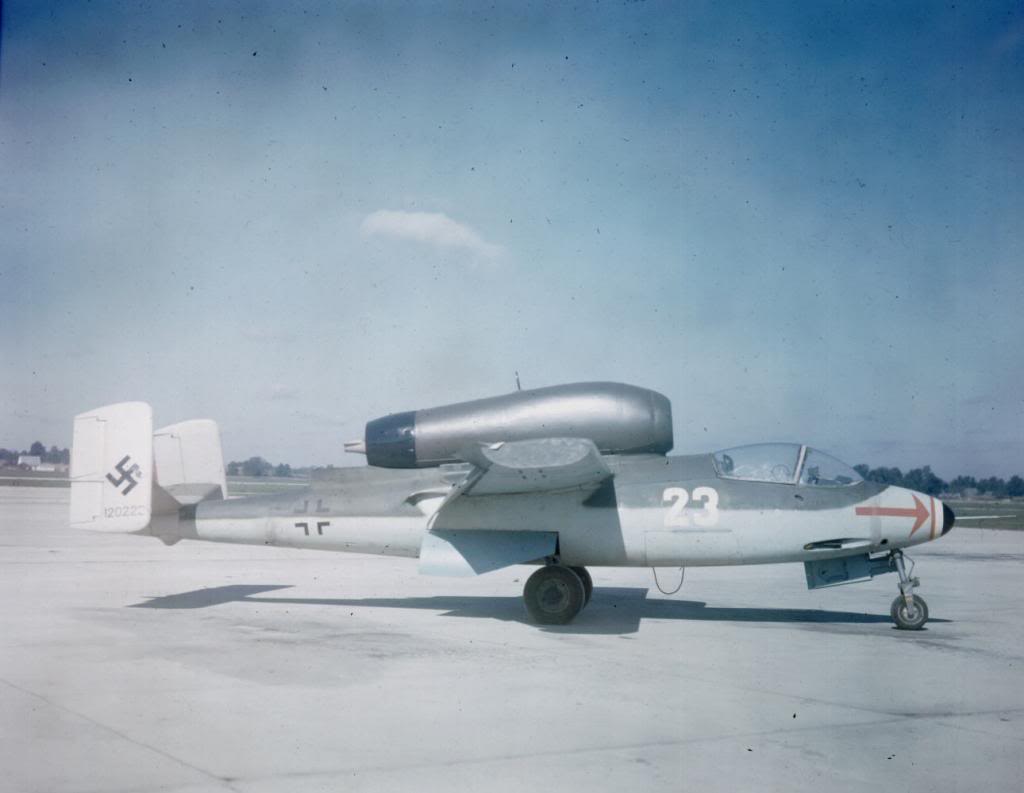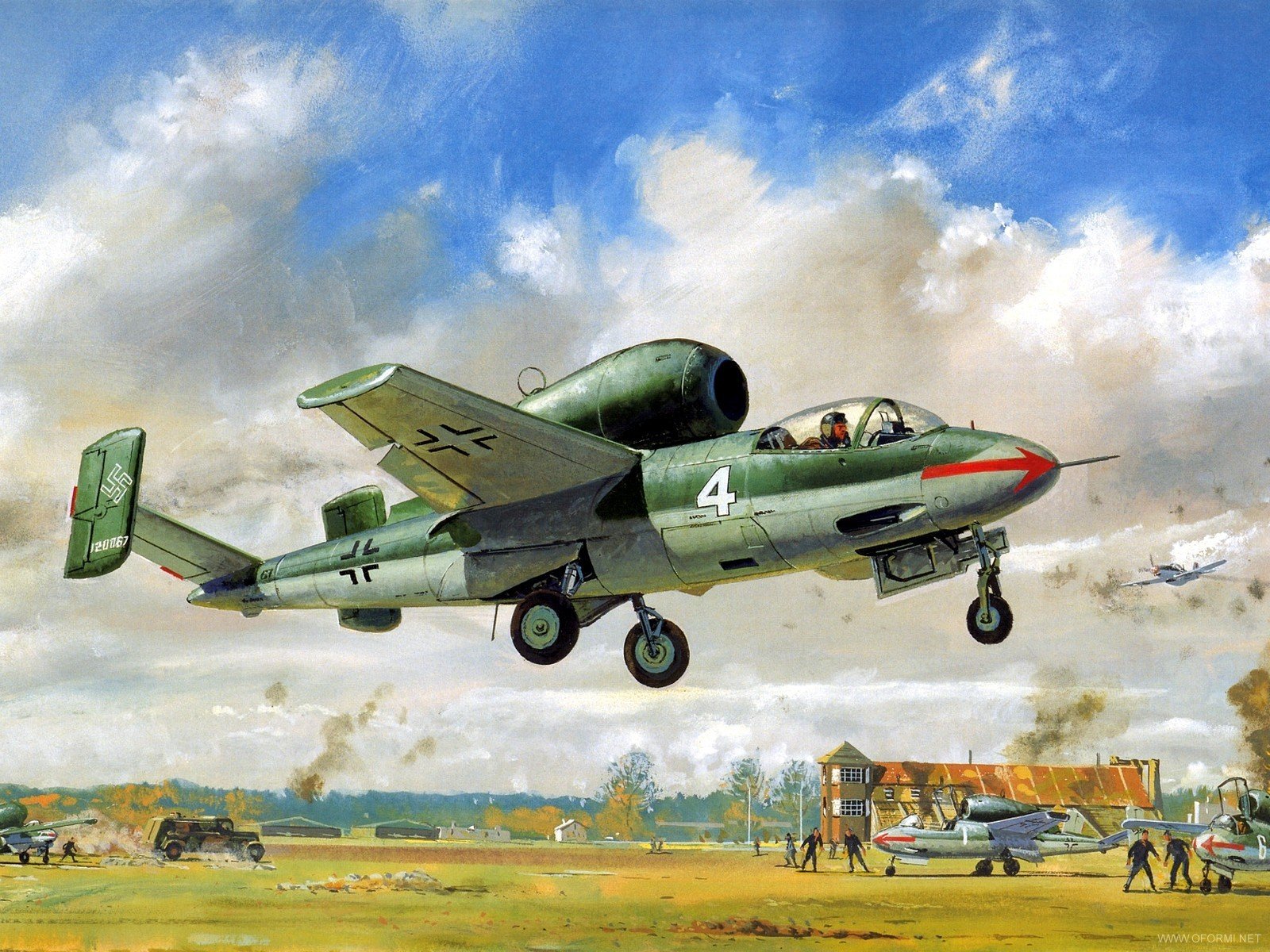
Volksjäger the story of the Heinkel He 162, the Nazi wooden jet
The Heinkel He 162 "Salamander" was a last-minute jet fighter project by the Nazis in 1944, using a wood-and-metal construction and a single engine. It was designed to be flown by anyone, but faced many challenges and limitations. Learn about its history, design, performance, and legacy from this article by a guest author.

Heinkel He 162 Volksjäger PlaneEncyclopedia
The He 162 had impressive performance capabilities for its time. Powered by a single BMW 003 turbojet engine, it could reach speeds of up to 562 mph (904 km/h) and had a service ceiling of 39,370 feet (12,000 meters). Its armament consisted of two 20mm MG 151/20 cannons mounted in the nose, as well as the capacity to carry either unguided.

Heinkel He 162 e (с изображениями) Германия, Штурмовики
Learn about the Heinkel He 162, a single-seat, single jet engine fighter-interceptor that was developed by Germany in 1944 to counter the Allied bomber campaign. Find out its specifications, features, performance, history, and legacy of this unique and innovative aircraft.

Heinkel He162A2 Volksjager Germany Air Force Aviation Photo
He 162 is an excellent bomber hunter, especially if you choose to fly with minimum (8 min) fuel and go to intercept bombers attacking your team's bases. Your 20 mm and small size will make you a deadly opponent, but keep in mind that most propeller bombers at this rank have great defensive armaments. When up-tiered with jets you will probably.

Heinkel He162A2 Volksjager Germany Air Force Aviation Photo
The Heinkel He 162 jet fighter was conceived, designed, and built in 90 days as a last attempt by Germany to avoid defeat in Second World War. Intended as an inexpensive fighter, the Heinkel He 162 could be built by semi-skilled labour out of non-strategic materials. After initial aerodynamic and structural problems were solved, the German Air.

HISTORIAS DE LA AVIACIÓN AVIONES ALEMANES DE LA II GUERRA MUNDIAL
The Heinkel He 162 Volksjäger (German, "People's Fighter") was a German single-engine, jet-powered fighter aircraft fielded by the Luftwaffe late in World War II.Developed under the Emergency Fighter Program, it was designed and built quickly and made primarily of wood as metals were in very short supply and prioritised for other aircraft. Volksjäger was the Reich Air Ministry's official.

Heinkel He 162 Large Preview
The Heinkel He 162 Volksjäger was a German single-engine, jet-powered fighter aircraft fielded by the Luftwaffe in World War II. Developed under the Emergency Fighter Program, it was designed and built quickly and made primarily of wood as metals were in very short supply and prioritised for other aircraft. Volksjäger was the Reich Air Ministry's official name for the government design.

Heinkel He162A2 Volksjager Germany Air Force Aviation Photo
Learn about the history and features of the Heinkel He 162, a low-altitude jet fighter developed by Nazi Germany in 1944 to counter the Allied bomber raids. Find out how the project was born, what were the requirements, the challenges and the results of this cheap and easy to build fighter.

Heinkel He162A2 Volksjager Germany Air Force Aviation Photo
Introduction. The Heinkel He 162 Spatz, better known as the Volksjäger, or People's Fighter, was a single-engined jet fighter went from a basic design to its maiden flight in three months at the end of 1944, but that had barely entered service before the end of the Second World War. Development. The concept of the Volksjäger, or people's.

Pin on Heinkel He162
(note: the He 162 has often been erroneously referred to as the Salmander. The term is a codename for the wing structure, not the aircraft.) Heinkel designed and built the first prototype of the He 162 in record time. Just 74 days passed between the day Heinkel received the contract on September 23 and first flight on December 6.

2014 Duxford Flying Legend show Heinkel he 162, Aircraft
Learn about the Heinkel He 162, a Volksjäger (People's Fighter) powered by a single BMW 003 jet engine that was designed to meet the specifications of the Reichsluftfahrtministerium (German Air Ministry) for a light jet fighter. Find out how the He 162 performed in combat, its design and development, and its legacy in World War II history.

Heinkel, He 162A2, Spatz Volksjager. "yellow "4" (W. nr 120076) of 1
Learn about the He 162, the first jet fighter built by Heinkel, which was designed to meet the RLM's requirements for a fast, agile and single-engine aircraft with two 30 mm cannons. Find out how the He 162 was built, tested and produced in a hurry, and how it performed in the war against the Allies.

Heinkel He162. Aircraft, Heinkel he 162, Fighter jets
Learn how Heinkel's jet-powered He-162 was developed and produced in 74 days, using steel and wood, to compete with the Me-262 Schwalbe. Find out why the He-162 was not a success, due to its design, performance and safety issues.

Heinkel He162A1 Volksjager Germany Air Force Aviation Photo
Other He 162 variants under consideration included the "He 162C", with the B-series fuselage, Heinkel-Hirth 011A engine, swept wing, and "vee" or "butterfly" tail assembly; and the "He 162D", with a similar configuration, but a forward-swept wing. They were to me armed with twin MK 108 30-millimeter cannon, with a scheme considered in which the.

Heinkel He 162
The Heinkel He 162 was a cheap and hurriedly designed jet fighter by Nazi Germany in 1945, using wood for its construction. It was designed for mass production by semi-skilled labour and had unpleasant flying characteristics. It was never used in combat and had a pulsejet project as a possible alternative.

Heinkel He162A1 Volksjager Germany Air Force Aviation Photo
Under the high priority given to fighter programs in 1944-45, manufacture of the He 162, under the code name Salamander, was assigned to numerous factories. It was planned to produce 2,000 a month by May 1945 and 4,000 a month ultimately, and about 800 were in various stages of assembly when the war in Europe ended.